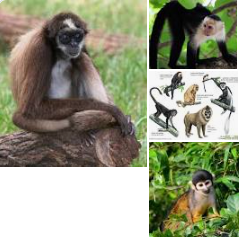
40mya Platyrrhini
MARMOSETS, TAMARINS, CAPUCHINS, SQUIRREL MONKEYS, NIGHT MONKEYS, TITI, SAKI, UAKARIS, WOOLY, SPIDER AND HOWLER MONKEYS.
New World monkeys are the five families of primates that are found in the tropical regions of Mexico, Central and South America.
Platyrrhini means broad-nosed, and their noses are flatter than those of other simians, with sideways-facing nostrils. Monkeys in the family Atelidae, such as the spider monkey, are the only primates to have prehensile tails.
New World monkeys' closest relatives are the other simians, the Catarrhini ("down-nosed"), comprising Old World monkeys and apes. New World monkeys descend from African simians that colonized South America, a line that split off about 40 million years ago.
While our remote vertebrate ancestors possessed trichromatic vision, our nocturnal, warm-blooded, mammalian ancestors lost one of three cones in the retina at the time of dinosaurs. This is why fish, reptiles and birds are trichromatic while all mammals with the exception of apes and New World monkeys are strictly handicapped dichromats. Because color vision is of paramount importance to diurnal animals that eat ripe fruits, apes and New World monkeys regained tri-color vision independently via chromosomal translocation. In apes, trichromacy resulted from true duplication of the opsin gene.
-
Ancestor's Trail Hike
-
Why Is Life On Earth Carbon-Based?
-
Metazoans
-
900MYA we had a common ancestry with Choanoflagellates (non-animal eucaryotes)
-
800mya we had a common ancestry with Sponges
-
780mya we had a common ancestry with Placozoans
-
730mya Ctenophores
-
680mya Cnidarians
-
630mya Flatworms
-
590mya Protosomes
-
570mya Ambulacrarians
-
565mya Tunicates
-
560mya Cephalocordates
-
530mya Agnatha
-
460mya Chondrichthyes
-
440-450mya FIRST GREAT EXTINCTION
-
440mya Actinopterygii
-
417mya Dipnoi
-
360-375mya SECOND GREAT EXTINCTION
-
340mya Amphibians
-
310mya Sauropsids (lizard-faced non-mammalian chordates)
-
251mya THIRD GREAT EXTINCTION
-
205mya FOURTH GREAT EXTINCTION
-
180mya Monotremes
-
140mya Marsupials
-
105mya Afrotheres
-
95mya Xenarthrans
-
85mya Laurasiatheres
-
75mya Glires (Rodents and Lagomorphs)
-
70mya Non-primate Eurachonta (Cologus and Tree shrews)
-
65mya FIFTH GREAT EXTINCTION
-
63mya Prosimians
-
58mya Tarsiers
-
40mya Platyrrhini
-
25mya Catarrhini
-
18mya Lesser Apes
-
14mya Orangutans
-
7mya Gorillas
-
6mya Chimpanzees and Bonobos
-
Human Evolution on the Ancestor's Trail
-
7 BILLION HUMANS